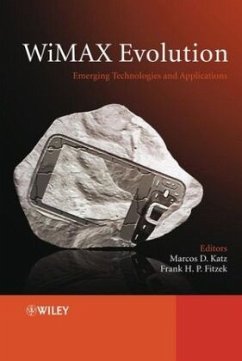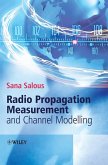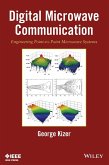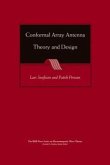WiMAX Evolution
Emerging Technologies and Applications
Ed. by Marcos Katz and Frank Fitzek
Schade – dieser Artikel ist leider ausverkauft. Sobald wir wissen, ob und wann der Artikel wieder verfügbar ist, informieren wir Sie an dieser Stelle.
WiMAX Evolution
Emerging Technologies and Applications
Ed. by Marcos Katz and Frank Fitzek
- Gebundenes Buch
- Merkliste
- Auf die Merkliste
- Bewerten Bewerten
- Teilen
- Produkt teilen
- Produkterinnerung
- Produkterinnerung
WiMAX is one of the most studied technologies today, and one of the strongest proponents for becoming the underlying technology of future high-performance wireless networks. Focusing on the future developments of WiMAX technology, this unique book covers most of the relevant evolutionary aspects of WiMAX, from the physical to the application layer, including visions from industry, standardization, and research community. Featuring a balanced mix of contributions from highly regarded professionals, WiMAX Evolution is an ideal reference for professionals in product development, research…mehr
Andere Kunden interessierten sich auch für
![Hspa Performance and Evolution Hspa Performance and Evolution]() Pablo TapiaHspa Performance and Evolution136,99 €
Pablo TapiaHspa Performance and Evolution136,99 €![Antennas for Portable Devices Antennas for Portable Devices]() Zhi Ning Chen (ed.)Antennas for Portable Devices147,99 €
Zhi Ning Chen (ed.)Antennas for Portable Devices147,99 €![Vsat Networks Vsat Networks]() Gerard MaralVsat Networks184,99 €
Gerard MaralVsat Networks184,99 €![Radio Propagation Measurement and Channel Modelling Radio Propagation Measurement and Channel Modelling]() Sana SalousRadio Propagation Measurement and Channel Modelling152,99 €
Sana SalousRadio Propagation Measurement and Channel Modelling152,99 €![Digital Microwave Communication Digital Microwave Communication]() George KizerDigital Microwave Communication170,99 €
George KizerDigital Microwave Communication170,99 €![Conformal Array Antenna Theory and Design Conformal Array Antenna Theory and Design]() Lars JoseffssonConformal Array Antenna Theory and Design188,99 €
Lars JoseffssonConformal Array Antenna Theory and Design188,99 €![Adaptive Antennas for Wireless Communications Adaptive Antennas for Wireless Communications]() George V. Tsoulos (Hrsg.)Adaptive Antennas for Wireless Communications281,99 €
George V. Tsoulos (Hrsg.)Adaptive Antennas for Wireless Communications281,99 €-
-
-
WiMAX is one of the most studied technologies today, and one of the strongest proponents for becoming the underlying technology of future high-performance wireless networks. Focusing on the future developments of WiMAX technology, this unique book covers most of the relevant evolutionary aspects of WiMAX, from the physical to the application layer, including visions from industry, standardization, and research community. Featuring a balanced mix of contributions from highly regarded professionals, WiMAX Evolution is an ideal reference for professionals in product development, research engineers and scientists, standardization engineers, professors, and advanced students.
This book presents the evolutionary and visionary developments of WiMAX!
WiMAX Evolution: Emerging Technologies and Applications focuses on the future developments of WiMAX technology. The book discusses the evolutionary aspects of WiMAX, from the physical to the application layer, including visions from industry, standardization and research communities. Several chapters of the book will present very new and unique information as editors and their respective organizations are involved in ongoing international projects on WiMAX, developing advanced WiMAX techniques. The Editors' in-house WiMAX test-beds enhance the book with privileged and seldom published information on practical issues.
Key features:
Presents evolutionary and visionary developments of WiMAX, motivating and inspiring readers to join and continue the developing work
Contains chapters with previously unpublished material, including measurements on real WiMAX equipment and their validation, and introduction of robust header compression in WiMAX, and more
Unique results on real WiMAX test-beds
Covers WiMAX validation, novel scenarios, applications and business, advanced WiMAX architectures, WiMAX extensions, and WiMAX evolution and future developments
Expert authorship with a balanced mix of contributions from highly regarded professionals from top research institutes, industry and academia
This book is an invaluable resource for product developers, research and standardization engineers in industry, professors, research scientists and advanced students in academia. Technology managers and CTOs will also find this book insightful.
This book presents the evolutionary and visionary developments of WiMAX!
WiMAX Evolution: Emerging Technologies and Applications focuses on the future developments of WiMAX technology. The book discusses the evolutionary aspects of WiMAX, from the physical to the application layer, including visions from industry, standardization and research communities. Several chapters of the book will present very new and unique information as editors and their respective organizations are involved in ongoing international projects on WiMAX, developing advanced WiMAX techniques. The Editors' in-house WiMAX test-beds enhance the book with privileged and seldom published information on practical issues.
Key features:
Presents evolutionary and visionary developments of WiMAX, motivating and inspiring readers to join and continue the developing work
Contains chapters with previously unpublished material, including measurements on real WiMAX equipment and their validation, and introduction of robust header compression in WiMAX, and more
Unique results on real WiMAX test-beds
Covers WiMAX validation, novel scenarios, applications and business, advanced WiMAX architectures, WiMAX extensions, and WiMAX evolution and future developments
Expert authorship with a balanced mix of contributions from highly regarded professionals from top research institutes, industry and academia
This book is an invaluable resource for product developers, research and standardization engineers in industry, professors, research scientists and advanced students in academia. Technology managers and CTOs will also find this book insightful.
Produktdetails
- Produktdetails
- Verlag: Wiley & Sons
- Artikelnr. des Verlages: 14569680000
- 1. Auflage
- Seitenzahl: 502
- Erscheinungstermin: 2. März 2009
- Englisch
- Abmessung: 255mm x 177mm x 34mm
- Gewicht: 978g
- ISBN-13: 9780470696804
- ISBN-10: 047069680X
- Artikelnr.: 25050637
- Herstellerkennzeichnung
- Libri GmbH
- Europaallee 1
- 36244 Bad Hersfeld
- gpsr@libri.de
- Verlag: Wiley & Sons
- Artikelnr. des Verlages: 14569680000
- 1. Auflage
- Seitenzahl: 502
- Erscheinungstermin: 2. März 2009
- Englisch
- Abmessung: 255mm x 177mm x 34mm
- Gewicht: 978g
- ISBN-13: 9780470696804
- ISBN-10: 047069680X
- Artikelnr.: 25050637
- Herstellerkennzeichnung
- Libri GmbH
- Europaallee 1
- 36244 Bad Hersfeld
- gpsr@libri.de
Dr Marcos Katz, VTT, Finland Dr Katz received his PhD from University of Oulu, Finland in 2002. He has 20 years of experience in the field of wireless communications (industry, academia and, research institutions). He has edited 2 books and published widely in journals and conferences. He is currently a Technical Manager of EU FP6 Integrated Project dealing with new WiMAX scenarios, technical solutions and test-beds. He is developing multiantenna solutions for new WiMAX scenarios (environmental monitoring), and is also involved in exploring novel WiMAX architectures exploiting cooperation. Professor Frank Fitzek, Aalborg University, Denmark Frank Fitzek is an Associate Professor in the Dept. of Communication Technology, University of Aalborg, Denmark, heading the Future Vision and Mobile Device group. His current research interests are in the areas of wireless and mobile communication networks, mobile phone programming, cross layer as well as energy efficient protocol design and cooperative networking. Currently Dr. Fitzek is working on robust header compression (ROHC) techniques for WiMAX as well as exploring cooperative networking concepts in WiMAX
Contents
List of Contributors
Foreword
Preface
Acknowledgements
List of Acronyms
I Introduction
1 Introduction to WiMAX Technology
Wonil Roh and Vladimir Yanover
1.1 Overview of State-of-the-artWiMAX Technology
1.2 WiMAXEvolutionPath
References
II WiMAX Validation: Validating Current Fixed and
MobileWiMAX Through Advanced Testbeds
2 WiMAX Performance in Practice
Kostas Pentikousis, Esa Piri, Jarno Pinola and Ilkka Harjula
2.1 EmpiricalEvaluationsofWiMAX
2.2 FixedWiMAXTestbedEvaluation
2.3 VoIPOverFixedWiMAX
2.4 IPTVoverfixedWiMAX
2.5 MobileWiMAXTestbedEvaluation
2.6 Summary
2.7 FurtherReading
References .
III Novel Scenarios
3 NovelWiMAX Scenarios for Future BroadbandWireless Access Networks
Pedro Neves, Kostas Pentikousis, Susana Sargento, Marília Curado, Paulo
Simões
and Francisco Fontes
3.1 Introduction
3.2 WMANNetworkProvider
3.3 TelemedicineApplications
3.4 EnvironmentalMonitoring .
3.5 Conclusions
References
4 Pricing in WiMAX Networks
Ioannis Papapanagiotou, Jie Hui and Michael Devetsikiotis
4.1 Introduction
4.2 Economics in Network Engineering
4.3 BuildingthePricingSchemes
4.4 Pricing in DifferentWiMAX Topologies
4.5 Conclusion
References
IV Advanced WiMAX Architectures
5 WiMAX Femtocells
Chris Smart, Clare Somerville and Doug Pulley
5.1 Introduction
5.2 Architectureof aWiMAXFemtocell
5.3 Femtocell Fundamentals
5.4 Femtocell-Macrocell Interference
References
6 Cooperative Principles in WiMAX
Qi Zhang, Frank H.P. Fitzek and Marcos D. Katz
6.1 Introduction
6.2 Cooperative Diversity Schemes in Mobile Multihop Relay Based WiMAX
(802.16j)
6.3 Cooperative Schemes for Multicast Broadcast Services in WiMAX .
6.4 Network Coding Implementation in the CommercialWiMAX Mobile Device
6.5 Conclusion
References
viii CONTENTS
7 The Role of WiMAX Technology in Distributed Wide Area Monitoring
Applications
Francesco Chiti, Romano Fantacci, Leonardo Maccari, Dania Marabissi and
Daniele Tarchi
7.1 MonitoringwiththeWSNParadigm
7.2 OverallSystemArchitecture
7.3 Efficient Access Management Schemes
7.4 SecureCommunicationsApproaches
References
8 WiMAX Mesh Architectures and Network Coding
Parag S. Mogre, Matthias Hollick, Christian Schwingenschloegl, Andreas
Ziller
and Ralf Steinmetz
8.1 Introduction
8.2 Background on the IEEE 802.16 MeSH Mode
8.3 Design Principles for Network Coding in the IEEE 802.16 MeSH Mode
8.4 EnablingWNC for the IEEE 802.16 MeSH Mode
8.5 RelatedWork
8.6 ConclusionsandOutlook
References
9 ASN-GWHigh Availability through Cooperative Networking in Mobile
WiMAX Deployments
Alexander Bachmutsky
9.1 Introduction
9.2 ClassicHAImplementation
9.3 Network-based Resiliency Solutions for Routing
9.4 WiMAXNetworkElementsR4/R6HealthManagement
9.5 R6LoadBalancing
9.6 ASN-GWFailure andRecovery
9.7 N:N Redundancy
9.8 Multi-instance ASN-GW
9.9 The Proposal Summary
9.10 Conclusions
V WiMAX Extensions
10 Robust Header Compression forWiMAX Femto Cells
Frank H.P. Fitzek, Gerrit Schulte, Esa Piri, Jarno Pinola, Marcos D. Katz,
Jyrki Huusko, Kostas Pentikousis and Patrick Seeling
CONTENTS
10.1 Introduction
10.2 ROHCinaNutshell
10.3 ScenarioUnder Investigation
10.4 WiMAXandROHCMeasurementSetup
10.5 WiMAXandROHCMeasurementsResults
10.6 Conclusion
References
11 A WiMAX Cross-layer Framework for Next Generation Networks
Pedro Neves, Susana Sargento, Ricardo Matos, Giada Landi, Kostas
Pentikousis,
Marília Curado and Francisco Fontes
11.1 Introduction
11.2 IEEE 802.16 Reference Model
11.3 Cross-layerDesignforWiMAXNetworks
11.4 WEIRD:APracticalCase ofWiMAXCross-layerDesign
11.5 WEIRDFrameworkPerformanceEvaluation
11.6 Summary
References
12 Speech Quality Aware Resource Control for Fixed and Mobile WiMAX
Thomas Michael Bohnert, Dirk Staehle and Edmundo Monteiro
12.1 Introduction
12.2 Quality of Experience versus Quality of Service Assessment
12.3 Methods for Speech Quality Assessment
12.4 Continuous Speech Quality Assessment for VoIP
12.5 Speech Quality Aware Admission Control for Fixed IEEE 802.16Wireless
12.6 The Idea of an R-score-basedScheduler
12.7 Conclusion
References
13 VoIP overWiMAX
Rath Vannithamby and Roshni Srinivasan
13.1 Introduction
13.2 Features to Support VoIP overWiMAX
13.3 EnhancedFeatures for ImprovedVoIPCapacity
13.4 SimulationResults
13.5 Conclusion
References
14 WiMAX User Data Load Balancing
Alexander Bachmutsky
14.1 Introduction
14.2 LocalBreakoutUse forLoadBalancing
14.3 Network-level Load Balancing over Tunneled Interfaces
14.4 Conclusions .
15 Enabling Per-flow and System-wide QoS and QoE in Mobile WiMAX
Thomas Casey, Xiongwen Zhao, Nenad Veselinovic, Jari Nurmi and Riku Jäntti
15.1 Introduction
15.2 Overview
15.3 Per-flow-basedQoSandQoE
15.4 System-wideTools forEnablingQoSandQoE
15.5 Conclusions
References
VI WiMAX Evolution and Future Developments
16 MIMO Technologies forWiMAX Systems: Present and Future
Chan-Byoung Chae, Kaibin Huang and Takao Inoue
16.1 Introduction
16.2 IEEE802.16e: Single-user MIMO Technologies
6.3 IEEE802.16m: Evolution Towards Multiuser MIMO Technologies - Part I.
NonlinearProcessing
16.4 IEEE802.16m: Evolution Towards Multiuser MIMO Technologies - Part II.
LinearProcessing
16.5 Conclusion
References
17 Hybrid Strategies for Link Adaptation Exploiting Several Degrees of
Freedom inWiMAX Systems
Suvra Sekhar Das, Muhammad Imadur Rahman and Yuanye Wang
17.1 Introduction
17.2 LinkAdaptationPreliminaries
17.3 LinkAdaptationAlgorithms
17.4 LinkAdaptationScenario
17.5 PowerAdaptationwithBitAdaptation
17.6 LinkAdaptationConsideringSeveralSystemIssues
17.7 Summary
References
18 ApplyingWiMAX in New Scenarios: Limitations of the Physical Layer
and Possible Solutions
Ilkka Harjula, Paola Cardamone, Matti Weissenfelt, Mika Lasanen,
Sandrine Boumard, Aaron Byman and Marcos D. Katz
18.1 WiMAXinNewScenarios
18.2 Channel Model for Mountainous Environments
18.3 Mountainous Scenario and Channel Modeling
18.4 BeamformingAlgorithmsandSimulation
18.5 A Timing Synchronization Study in a Mountain Environment .
18.6 Analysis andConclusions
References
19 Application of Radio-over-Fiber in WiMAX: Results and Prospects
Juan Luis Corral, Roberto Llorente, Valentín Polo, Borja Vidal, Javier
Martí,
Jonás Porcar, David Zorrilla and Antonio José Ramírez
19.1 Introduction
19.2 OpticalTransmissionofWiMAXSignals
19.3 WiMAX-on-FiberApplications
19.4 Conclusions
References .
CONTENTS
20 Network Planning and its Part in FutureWiMAX Systems 399
Avraham Freedman and Moshe Levin
20.1 Introduction
20.2 TheNetworkPlanningProcess
20.3 The ImpactofWiMAXonNetworkPlanning
20.4 PlanningofFutureWiMAXNetworks
20.5 Modeling: theKeytoIntegrationofPlanningInformation
20.6 Conclusions
References
21 WiMAX Network Automation: Neighbor Discovery, Capabilities
Negotiation, Auto-configuration and Network Topology Learning
Alexander Bachmutsky
21.1 Introduction
21.2 WiMAXNetworkElementsAuto-discovery
21.3 Automatic Learning of the WiMAX Network Topology
21.4 Capabilities Exchange
21.5 AutomaticWiMAXVersionManagement
21.6 AutomatedRoaming
21.7 Conclusion:NetworkAutomationas aWiMAXDifferentiator
References
22 An Overview of Next GenerationMobile WiMAX: Technology and Prospects
Sassan Ahmadi
22.1 Introduction
22.2 Summary of IEEE 802.16m System Requirements
22.3 Areasof ImprovementandExtensioninMobileWiMAX
22.4 IEEE 802.16m Architecture and Protocol Structure
22.5 IEEE 802.16m Mobile Station State Diagram
22.6 IEEE 802.16m Physical Layer
22.7 IEEE 802.16m MAC Layer
22.8 Conclusions
References
Index
List of Contributors
Foreword
Preface
Acknowledgements
List of Acronyms
I Introduction
1 Introduction to WiMAX Technology
Wonil Roh and Vladimir Yanover
1.1 Overview of State-of-the-artWiMAX Technology
1.2 WiMAXEvolutionPath
References
II WiMAX Validation: Validating Current Fixed and
MobileWiMAX Through Advanced Testbeds
2 WiMAX Performance in Practice
Kostas Pentikousis, Esa Piri, Jarno Pinola and Ilkka Harjula
2.1 EmpiricalEvaluationsofWiMAX
2.2 FixedWiMAXTestbedEvaluation
2.3 VoIPOverFixedWiMAX
2.4 IPTVoverfixedWiMAX
2.5 MobileWiMAXTestbedEvaluation
2.6 Summary
2.7 FurtherReading
References .
III Novel Scenarios
3 NovelWiMAX Scenarios for Future BroadbandWireless Access Networks
Pedro Neves, Kostas Pentikousis, Susana Sargento, Marília Curado, Paulo
Simões
and Francisco Fontes
3.1 Introduction
3.2 WMANNetworkProvider
3.3 TelemedicineApplications
3.4 EnvironmentalMonitoring .
3.5 Conclusions
References
4 Pricing in WiMAX Networks
Ioannis Papapanagiotou, Jie Hui and Michael Devetsikiotis
4.1 Introduction
4.2 Economics in Network Engineering
4.3 BuildingthePricingSchemes
4.4 Pricing in DifferentWiMAX Topologies
4.5 Conclusion
References
IV Advanced WiMAX Architectures
5 WiMAX Femtocells
Chris Smart, Clare Somerville and Doug Pulley
5.1 Introduction
5.2 Architectureof aWiMAXFemtocell
5.3 Femtocell Fundamentals
5.4 Femtocell-Macrocell Interference
References
6 Cooperative Principles in WiMAX
Qi Zhang, Frank H.P. Fitzek and Marcos D. Katz
6.1 Introduction
6.2 Cooperative Diversity Schemes in Mobile Multihop Relay Based WiMAX
(802.16j)
6.3 Cooperative Schemes for Multicast Broadcast Services in WiMAX .
6.4 Network Coding Implementation in the CommercialWiMAX Mobile Device
6.5 Conclusion
References
viii CONTENTS
7 The Role of WiMAX Technology in Distributed Wide Area Monitoring
Applications
Francesco Chiti, Romano Fantacci, Leonardo Maccari, Dania Marabissi and
Daniele Tarchi
7.1 MonitoringwiththeWSNParadigm
7.2 OverallSystemArchitecture
7.3 Efficient Access Management Schemes
7.4 SecureCommunicationsApproaches
References
8 WiMAX Mesh Architectures and Network Coding
Parag S. Mogre, Matthias Hollick, Christian Schwingenschloegl, Andreas
Ziller
and Ralf Steinmetz
8.1 Introduction
8.2 Background on the IEEE 802.16 MeSH Mode
8.3 Design Principles for Network Coding in the IEEE 802.16 MeSH Mode
8.4 EnablingWNC for the IEEE 802.16 MeSH Mode
8.5 RelatedWork
8.6 ConclusionsandOutlook
References
9 ASN-GWHigh Availability through Cooperative Networking in Mobile
WiMAX Deployments
Alexander Bachmutsky
9.1 Introduction
9.2 ClassicHAImplementation
9.3 Network-based Resiliency Solutions for Routing
9.4 WiMAXNetworkElementsR4/R6HealthManagement
9.5 R6LoadBalancing
9.6 ASN-GWFailure andRecovery
9.7 N:N Redundancy
9.8 Multi-instance ASN-GW
9.9 The Proposal Summary
9.10 Conclusions
V WiMAX Extensions
10 Robust Header Compression forWiMAX Femto Cells
Frank H.P. Fitzek, Gerrit Schulte, Esa Piri, Jarno Pinola, Marcos D. Katz,
Jyrki Huusko, Kostas Pentikousis and Patrick Seeling
CONTENTS
10.1 Introduction
10.2 ROHCinaNutshell
10.3 ScenarioUnder Investigation
10.4 WiMAXandROHCMeasurementSetup
10.5 WiMAXandROHCMeasurementsResults
10.6 Conclusion
References
11 A WiMAX Cross-layer Framework for Next Generation Networks
Pedro Neves, Susana Sargento, Ricardo Matos, Giada Landi, Kostas
Pentikousis,
Marília Curado and Francisco Fontes
11.1 Introduction
11.2 IEEE 802.16 Reference Model
11.3 Cross-layerDesignforWiMAXNetworks
11.4 WEIRD:APracticalCase ofWiMAXCross-layerDesign
11.5 WEIRDFrameworkPerformanceEvaluation
11.6 Summary
References
12 Speech Quality Aware Resource Control for Fixed and Mobile WiMAX
Thomas Michael Bohnert, Dirk Staehle and Edmundo Monteiro
12.1 Introduction
12.2 Quality of Experience versus Quality of Service Assessment
12.3 Methods for Speech Quality Assessment
12.4 Continuous Speech Quality Assessment for VoIP
12.5 Speech Quality Aware Admission Control for Fixed IEEE 802.16Wireless
12.6 The Idea of an R-score-basedScheduler
12.7 Conclusion
References
13 VoIP overWiMAX
Rath Vannithamby and Roshni Srinivasan
13.1 Introduction
13.2 Features to Support VoIP overWiMAX
13.3 EnhancedFeatures for ImprovedVoIPCapacity
13.4 SimulationResults
13.5 Conclusion
References
14 WiMAX User Data Load Balancing
Alexander Bachmutsky
14.1 Introduction
14.2 LocalBreakoutUse forLoadBalancing
14.3 Network-level Load Balancing over Tunneled Interfaces
14.4 Conclusions .
15 Enabling Per-flow and System-wide QoS and QoE in Mobile WiMAX
Thomas Casey, Xiongwen Zhao, Nenad Veselinovic, Jari Nurmi and Riku Jäntti
15.1 Introduction
15.2 Overview
15.3 Per-flow-basedQoSandQoE
15.4 System-wideTools forEnablingQoSandQoE
15.5 Conclusions
References
VI WiMAX Evolution and Future Developments
16 MIMO Technologies forWiMAX Systems: Present and Future
Chan-Byoung Chae, Kaibin Huang and Takao Inoue
16.1 Introduction
16.2 IEEE802.16e: Single-user MIMO Technologies
6.3 IEEE802.16m: Evolution Towards Multiuser MIMO Technologies - Part I.
NonlinearProcessing
16.4 IEEE802.16m: Evolution Towards Multiuser MIMO Technologies - Part II.
LinearProcessing
16.5 Conclusion
References
17 Hybrid Strategies for Link Adaptation Exploiting Several Degrees of
Freedom inWiMAX Systems
Suvra Sekhar Das, Muhammad Imadur Rahman and Yuanye Wang
17.1 Introduction
17.2 LinkAdaptationPreliminaries
17.3 LinkAdaptationAlgorithms
17.4 LinkAdaptationScenario
17.5 PowerAdaptationwithBitAdaptation
17.6 LinkAdaptationConsideringSeveralSystemIssues
17.7 Summary
References
18 ApplyingWiMAX in New Scenarios: Limitations of the Physical Layer
and Possible Solutions
Ilkka Harjula, Paola Cardamone, Matti Weissenfelt, Mika Lasanen,
Sandrine Boumard, Aaron Byman and Marcos D. Katz
18.1 WiMAXinNewScenarios
18.2 Channel Model for Mountainous Environments
18.3 Mountainous Scenario and Channel Modeling
18.4 BeamformingAlgorithmsandSimulation
18.5 A Timing Synchronization Study in a Mountain Environment .
18.6 Analysis andConclusions
References
19 Application of Radio-over-Fiber in WiMAX: Results and Prospects
Juan Luis Corral, Roberto Llorente, Valentín Polo, Borja Vidal, Javier
Martí,
Jonás Porcar, David Zorrilla and Antonio José Ramírez
19.1 Introduction
19.2 OpticalTransmissionofWiMAXSignals
19.3 WiMAX-on-FiberApplications
19.4 Conclusions
References .
CONTENTS
20 Network Planning and its Part in FutureWiMAX Systems 399
Avraham Freedman and Moshe Levin
20.1 Introduction
20.2 TheNetworkPlanningProcess
20.3 The ImpactofWiMAXonNetworkPlanning
20.4 PlanningofFutureWiMAXNetworks
20.5 Modeling: theKeytoIntegrationofPlanningInformation
20.6 Conclusions
References
21 WiMAX Network Automation: Neighbor Discovery, Capabilities
Negotiation, Auto-configuration and Network Topology Learning
Alexander Bachmutsky
21.1 Introduction
21.2 WiMAXNetworkElementsAuto-discovery
21.3 Automatic Learning of the WiMAX Network Topology
21.4 Capabilities Exchange
21.5 AutomaticWiMAXVersionManagement
21.6 AutomatedRoaming
21.7 Conclusion:NetworkAutomationas aWiMAXDifferentiator
References
22 An Overview of Next GenerationMobile WiMAX: Technology and Prospects
Sassan Ahmadi
22.1 Introduction
22.2 Summary of IEEE 802.16m System Requirements
22.3 Areasof ImprovementandExtensioninMobileWiMAX
22.4 IEEE 802.16m Architecture and Protocol Structure
22.5 IEEE 802.16m Mobile Station State Diagram
22.6 IEEE 802.16m Physical Layer
22.7 IEEE 802.16m MAC Layer
22.8 Conclusions
References
Index
Contents
List of Contributors
Foreword
Preface
Acknowledgements
List of Acronyms
I Introduction
1 Introduction to WiMAX Technology
Wonil Roh and Vladimir Yanover
1.1 Overview of State-of-the-artWiMAX Technology
1.2 WiMAXEvolutionPath
References
II WiMAX Validation: Validating Current Fixed and
MobileWiMAX Through Advanced Testbeds
2 WiMAX Performance in Practice
Kostas Pentikousis, Esa Piri, Jarno Pinola and Ilkka Harjula
2.1 EmpiricalEvaluationsofWiMAX
2.2 FixedWiMAXTestbedEvaluation
2.3 VoIPOverFixedWiMAX
2.4 IPTVoverfixedWiMAX
2.5 MobileWiMAXTestbedEvaluation
2.6 Summary
2.7 FurtherReading
References .
III Novel Scenarios
3 NovelWiMAX Scenarios for Future BroadbandWireless Access Networks
Pedro Neves, Kostas Pentikousis, Susana Sargento, Marília Curado, Paulo
Simões
and Francisco Fontes
3.1 Introduction
3.2 WMANNetworkProvider
3.3 TelemedicineApplications
3.4 EnvironmentalMonitoring .
3.5 Conclusions
References
4 Pricing in WiMAX Networks
Ioannis Papapanagiotou, Jie Hui and Michael Devetsikiotis
4.1 Introduction
4.2 Economics in Network Engineering
4.3 BuildingthePricingSchemes
4.4 Pricing in DifferentWiMAX Topologies
4.5 Conclusion
References
IV Advanced WiMAX Architectures
5 WiMAX Femtocells
Chris Smart, Clare Somerville and Doug Pulley
5.1 Introduction
5.2 Architectureof aWiMAXFemtocell
5.3 Femtocell Fundamentals
5.4 Femtocell-Macrocell Interference
References
6 Cooperative Principles in WiMAX
Qi Zhang, Frank H.P. Fitzek and Marcos D. Katz
6.1 Introduction
6.2 Cooperative Diversity Schemes in Mobile Multihop Relay Based WiMAX
(802.16j)
6.3 Cooperative Schemes for Multicast Broadcast Services in WiMAX .
6.4 Network Coding Implementation in the CommercialWiMAX Mobile Device
6.5 Conclusion
References
viii CONTENTS
7 The Role of WiMAX Technology in Distributed Wide Area Monitoring
Applications
Francesco Chiti, Romano Fantacci, Leonardo Maccari, Dania Marabissi and
Daniele Tarchi
7.1 MonitoringwiththeWSNParadigm
7.2 OverallSystemArchitecture
7.3 Efficient Access Management Schemes
7.4 SecureCommunicationsApproaches
References
8 WiMAX Mesh Architectures and Network Coding
Parag S. Mogre, Matthias Hollick, Christian Schwingenschloegl, Andreas
Ziller
and Ralf Steinmetz
8.1 Introduction
8.2 Background on the IEEE 802.16 MeSH Mode
8.3 Design Principles for Network Coding in the IEEE 802.16 MeSH Mode
8.4 EnablingWNC for the IEEE 802.16 MeSH Mode
8.5 RelatedWork
8.6 ConclusionsandOutlook
References
9 ASN-GWHigh Availability through Cooperative Networking in Mobile
WiMAX Deployments
Alexander Bachmutsky
9.1 Introduction
9.2 ClassicHAImplementation
9.3 Network-based Resiliency Solutions for Routing
9.4 WiMAXNetworkElementsR4/R6HealthManagement
9.5 R6LoadBalancing
9.6 ASN-GWFailure andRecovery
9.7 N:N Redundancy
9.8 Multi-instance ASN-GW
9.9 The Proposal Summary
9.10 Conclusions
V WiMAX Extensions
10 Robust Header Compression forWiMAX Femto Cells
Frank H.P. Fitzek, Gerrit Schulte, Esa Piri, Jarno Pinola, Marcos D. Katz,
Jyrki Huusko, Kostas Pentikousis and Patrick Seeling
CONTENTS
10.1 Introduction
10.2 ROHCinaNutshell
10.3 ScenarioUnder Investigation
10.4 WiMAXandROHCMeasurementSetup
10.5 WiMAXandROHCMeasurementsResults
10.6 Conclusion
References
11 A WiMAX Cross-layer Framework for Next Generation Networks
Pedro Neves, Susana Sargento, Ricardo Matos, Giada Landi, Kostas
Pentikousis,
Marília Curado and Francisco Fontes
11.1 Introduction
11.2 IEEE 802.16 Reference Model
11.3 Cross-layerDesignforWiMAXNetworks
11.4 WEIRD:APracticalCase ofWiMAXCross-layerDesign
11.5 WEIRDFrameworkPerformanceEvaluation
11.6 Summary
References
12 Speech Quality Aware Resource Control for Fixed and Mobile WiMAX
Thomas Michael Bohnert, Dirk Staehle and Edmundo Monteiro
12.1 Introduction
12.2 Quality of Experience versus Quality of Service Assessment
12.3 Methods for Speech Quality Assessment
12.4 Continuous Speech Quality Assessment for VoIP
12.5 Speech Quality Aware Admission Control for Fixed IEEE 802.16Wireless
12.6 The Idea of an R-score-basedScheduler
12.7 Conclusion
References
13 VoIP overWiMAX
Rath Vannithamby and Roshni Srinivasan
13.1 Introduction
13.2 Features to Support VoIP overWiMAX
13.3 EnhancedFeatures for ImprovedVoIPCapacity
13.4 SimulationResults
13.5 Conclusion
References
14 WiMAX User Data Load Balancing
Alexander Bachmutsky
14.1 Introduction
14.2 LocalBreakoutUse forLoadBalancing
14.3 Network-level Load Balancing over Tunneled Interfaces
14.4 Conclusions .
15 Enabling Per-flow and System-wide QoS and QoE in Mobile WiMAX
Thomas Casey, Xiongwen Zhao, Nenad Veselinovic, Jari Nurmi and Riku Jäntti
15.1 Introduction
15.2 Overview
15.3 Per-flow-basedQoSandQoE
15.4 System-wideTools forEnablingQoSandQoE
15.5 Conclusions
References
VI WiMAX Evolution and Future Developments
16 MIMO Technologies forWiMAX Systems: Present and Future
Chan-Byoung Chae, Kaibin Huang and Takao Inoue
16.1 Introduction
16.2 IEEE802.16e: Single-user MIMO Technologies
6.3 IEEE802.16m: Evolution Towards Multiuser MIMO Technologies - Part I.
NonlinearProcessing
16.4 IEEE802.16m: Evolution Towards Multiuser MIMO Technologies - Part II.
LinearProcessing
16.5 Conclusion
References
17 Hybrid Strategies for Link Adaptation Exploiting Several Degrees of
Freedom inWiMAX Systems
Suvra Sekhar Das, Muhammad Imadur Rahman and Yuanye Wang
17.1 Introduction
17.2 LinkAdaptationPreliminaries
17.3 LinkAdaptationAlgorithms
17.4 LinkAdaptationScenario
17.5 PowerAdaptationwithBitAdaptation
17.6 LinkAdaptationConsideringSeveralSystemIssues
17.7 Summary
References
18 ApplyingWiMAX in New Scenarios: Limitations of the Physical Layer
and Possible Solutions
Ilkka Harjula, Paola Cardamone, Matti Weissenfelt, Mika Lasanen,
Sandrine Boumard, Aaron Byman and Marcos D. Katz
18.1 WiMAXinNewScenarios
18.2 Channel Model for Mountainous Environments
18.3 Mountainous Scenario and Channel Modeling
18.4 BeamformingAlgorithmsandSimulation
18.5 A Timing Synchronization Study in a Mountain Environment .
18.6 Analysis andConclusions
References
19 Application of Radio-over-Fiber in WiMAX: Results and Prospects
Juan Luis Corral, Roberto Llorente, Valentín Polo, Borja Vidal, Javier
Martí,
Jonás Porcar, David Zorrilla and Antonio José Ramírez
19.1 Introduction
19.2 OpticalTransmissionofWiMAXSignals
19.3 WiMAX-on-FiberApplications
19.4 Conclusions
References .
CONTENTS
20 Network Planning and its Part in FutureWiMAX Systems 399
Avraham Freedman and Moshe Levin
20.1 Introduction
20.2 TheNetworkPlanningProcess
20.3 The ImpactofWiMAXonNetworkPlanning
20.4 PlanningofFutureWiMAXNetworks
20.5 Modeling: theKeytoIntegrationofPlanningInformation
20.6 Conclusions
References
21 WiMAX Network Automation: Neighbor Discovery, Capabilities
Negotiation, Auto-configuration and Network Topology Learning
Alexander Bachmutsky
21.1 Introduction
21.2 WiMAXNetworkElementsAuto-discovery
21.3 Automatic Learning of the WiMAX Network Topology
21.4 Capabilities Exchange
21.5 AutomaticWiMAXVersionManagement
21.6 AutomatedRoaming
21.7 Conclusion:NetworkAutomationas aWiMAXDifferentiator
References
22 An Overview of Next GenerationMobile WiMAX: Technology and Prospects
Sassan Ahmadi
22.1 Introduction
22.2 Summary of IEEE 802.16m System Requirements
22.3 Areasof ImprovementandExtensioninMobileWiMAX
22.4 IEEE 802.16m Architecture and Protocol Structure
22.5 IEEE 802.16m Mobile Station State Diagram
22.6 IEEE 802.16m Physical Layer
22.7 IEEE 802.16m MAC Layer
22.8 Conclusions
References
Index
List of Contributors
Foreword
Preface
Acknowledgements
List of Acronyms
I Introduction
1 Introduction to WiMAX Technology
Wonil Roh and Vladimir Yanover
1.1 Overview of State-of-the-artWiMAX Technology
1.2 WiMAXEvolutionPath
References
II WiMAX Validation: Validating Current Fixed and
MobileWiMAX Through Advanced Testbeds
2 WiMAX Performance in Practice
Kostas Pentikousis, Esa Piri, Jarno Pinola and Ilkka Harjula
2.1 EmpiricalEvaluationsofWiMAX
2.2 FixedWiMAXTestbedEvaluation
2.3 VoIPOverFixedWiMAX
2.4 IPTVoverfixedWiMAX
2.5 MobileWiMAXTestbedEvaluation
2.6 Summary
2.7 FurtherReading
References .
III Novel Scenarios
3 NovelWiMAX Scenarios for Future BroadbandWireless Access Networks
Pedro Neves, Kostas Pentikousis, Susana Sargento, Marília Curado, Paulo
Simões
and Francisco Fontes
3.1 Introduction
3.2 WMANNetworkProvider
3.3 TelemedicineApplications
3.4 EnvironmentalMonitoring .
3.5 Conclusions
References
4 Pricing in WiMAX Networks
Ioannis Papapanagiotou, Jie Hui and Michael Devetsikiotis
4.1 Introduction
4.2 Economics in Network Engineering
4.3 BuildingthePricingSchemes
4.4 Pricing in DifferentWiMAX Topologies
4.5 Conclusion
References
IV Advanced WiMAX Architectures
5 WiMAX Femtocells
Chris Smart, Clare Somerville and Doug Pulley
5.1 Introduction
5.2 Architectureof aWiMAXFemtocell
5.3 Femtocell Fundamentals
5.4 Femtocell-Macrocell Interference
References
6 Cooperative Principles in WiMAX
Qi Zhang, Frank H.P. Fitzek and Marcos D. Katz
6.1 Introduction
6.2 Cooperative Diversity Schemes in Mobile Multihop Relay Based WiMAX
(802.16j)
6.3 Cooperative Schemes for Multicast Broadcast Services in WiMAX .
6.4 Network Coding Implementation in the CommercialWiMAX Mobile Device
6.5 Conclusion
References
viii CONTENTS
7 The Role of WiMAX Technology in Distributed Wide Area Monitoring
Applications
Francesco Chiti, Romano Fantacci, Leonardo Maccari, Dania Marabissi and
Daniele Tarchi
7.1 MonitoringwiththeWSNParadigm
7.2 OverallSystemArchitecture
7.3 Efficient Access Management Schemes
7.4 SecureCommunicationsApproaches
References
8 WiMAX Mesh Architectures and Network Coding
Parag S. Mogre, Matthias Hollick, Christian Schwingenschloegl, Andreas
Ziller
and Ralf Steinmetz
8.1 Introduction
8.2 Background on the IEEE 802.16 MeSH Mode
8.3 Design Principles for Network Coding in the IEEE 802.16 MeSH Mode
8.4 EnablingWNC for the IEEE 802.16 MeSH Mode
8.5 RelatedWork
8.6 ConclusionsandOutlook
References
9 ASN-GWHigh Availability through Cooperative Networking in Mobile
WiMAX Deployments
Alexander Bachmutsky
9.1 Introduction
9.2 ClassicHAImplementation
9.3 Network-based Resiliency Solutions for Routing
9.4 WiMAXNetworkElementsR4/R6HealthManagement
9.5 R6LoadBalancing
9.6 ASN-GWFailure andRecovery
9.7 N:N Redundancy
9.8 Multi-instance ASN-GW
9.9 The Proposal Summary
9.10 Conclusions
V WiMAX Extensions
10 Robust Header Compression forWiMAX Femto Cells
Frank H.P. Fitzek, Gerrit Schulte, Esa Piri, Jarno Pinola, Marcos D. Katz,
Jyrki Huusko, Kostas Pentikousis and Patrick Seeling
CONTENTS
10.1 Introduction
10.2 ROHCinaNutshell
10.3 ScenarioUnder Investigation
10.4 WiMAXandROHCMeasurementSetup
10.5 WiMAXandROHCMeasurementsResults
10.6 Conclusion
References
11 A WiMAX Cross-layer Framework for Next Generation Networks
Pedro Neves, Susana Sargento, Ricardo Matos, Giada Landi, Kostas
Pentikousis,
Marília Curado and Francisco Fontes
11.1 Introduction
11.2 IEEE 802.16 Reference Model
11.3 Cross-layerDesignforWiMAXNetworks
11.4 WEIRD:APracticalCase ofWiMAXCross-layerDesign
11.5 WEIRDFrameworkPerformanceEvaluation
11.6 Summary
References
12 Speech Quality Aware Resource Control for Fixed and Mobile WiMAX
Thomas Michael Bohnert, Dirk Staehle and Edmundo Monteiro
12.1 Introduction
12.2 Quality of Experience versus Quality of Service Assessment
12.3 Methods for Speech Quality Assessment
12.4 Continuous Speech Quality Assessment for VoIP
12.5 Speech Quality Aware Admission Control for Fixed IEEE 802.16Wireless
12.6 The Idea of an R-score-basedScheduler
12.7 Conclusion
References
13 VoIP overWiMAX
Rath Vannithamby and Roshni Srinivasan
13.1 Introduction
13.2 Features to Support VoIP overWiMAX
13.3 EnhancedFeatures for ImprovedVoIPCapacity
13.4 SimulationResults
13.5 Conclusion
References
14 WiMAX User Data Load Balancing
Alexander Bachmutsky
14.1 Introduction
14.2 LocalBreakoutUse forLoadBalancing
14.3 Network-level Load Balancing over Tunneled Interfaces
14.4 Conclusions .
15 Enabling Per-flow and System-wide QoS and QoE in Mobile WiMAX
Thomas Casey, Xiongwen Zhao, Nenad Veselinovic, Jari Nurmi and Riku Jäntti
15.1 Introduction
15.2 Overview
15.3 Per-flow-basedQoSandQoE
15.4 System-wideTools forEnablingQoSandQoE
15.5 Conclusions
References
VI WiMAX Evolution and Future Developments
16 MIMO Technologies forWiMAX Systems: Present and Future
Chan-Byoung Chae, Kaibin Huang and Takao Inoue
16.1 Introduction
16.2 IEEE802.16e: Single-user MIMO Technologies
6.3 IEEE802.16m: Evolution Towards Multiuser MIMO Technologies - Part I.
NonlinearProcessing
16.4 IEEE802.16m: Evolution Towards Multiuser MIMO Technologies - Part II.
LinearProcessing
16.5 Conclusion
References
17 Hybrid Strategies for Link Adaptation Exploiting Several Degrees of
Freedom inWiMAX Systems
Suvra Sekhar Das, Muhammad Imadur Rahman and Yuanye Wang
17.1 Introduction
17.2 LinkAdaptationPreliminaries
17.3 LinkAdaptationAlgorithms
17.4 LinkAdaptationScenario
17.5 PowerAdaptationwithBitAdaptation
17.6 LinkAdaptationConsideringSeveralSystemIssues
17.7 Summary
References
18 ApplyingWiMAX in New Scenarios: Limitations of the Physical Layer
and Possible Solutions
Ilkka Harjula, Paola Cardamone, Matti Weissenfelt, Mika Lasanen,
Sandrine Boumard, Aaron Byman and Marcos D. Katz
18.1 WiMAXinNewScenarios
18.2 Channel Model for Mountainous Environments
18.3 Mountainous Scenario and Channel Modeling
18.4 BeamformingAlgorithmsandSimulation
18.5 A Timing Synchronization Study in a Mountain Environment .
18.6 Analysis andConclusions
References
19 Application of Radio-over-Fiber in WiMAX: Results and Prospects
Juan Luis Corral, Roberto Llorente, Valentín Polo, Borja Vidal, Javier
Martí,
Jonás Porcar, David Zorrilla and Antonio José Ramírez
19.1 Introduction
19.2 OpticalTransmissionofWiMAXSignals
19.3 WiMAX-on-FiberApplications
19.4 Conclusions
References .
CONTENTS
20 Network Planning and its Part in FutureWiMAX Systems 399
Avraham Freedman and Moshe Levin
20.1 Introduction
20.2 TheNetworkPlanningProcess
20.3 The ImpactofWiMAXonNetworkPlanning
20.4 PlanningofFutureWiMAXNetworks
20.5 Modeling: theKeytoIntegrationofPlanningInformation
20.6 Conclusions
References
21 WiMAX Network Automation: Neighbor Discovery, Capabilities
Negotiation, Auto-configuration and Network Topology Learning
Alexander Bachmutsky
21.1 Introduction
21.2 WiMAXNetworkElementsAuto-discovery
21.3 Automatic Learning of the WiMAX Network Topology
21.4 Capabilities Exchange
21.5 AutomaticWiMAXVersionManagement
21.6 AutomatedRoaming
21.7 Conclusion:NetworkAutomationas aWiMAXDifferentiator
References
22 An Overview of Next GenerationMobile WiMAX: Technology and Prospects
Sassan Ahmadi
22.1 Introduction
22.2 Summary of IEEE 802.16m System Requirements
22.3 Areasof ImprovementandExtensioninMobileWiMAX
22.4 IEEE 802.16m Architecture and Protocol Structure
22.5 IEEE 802.16m Mobile Station State Diagram
22.6 IEEE 802.16m Physical Layer
22.7 IEEE 802.16m MAC Layer
22.8 Conclusions
References
Index








